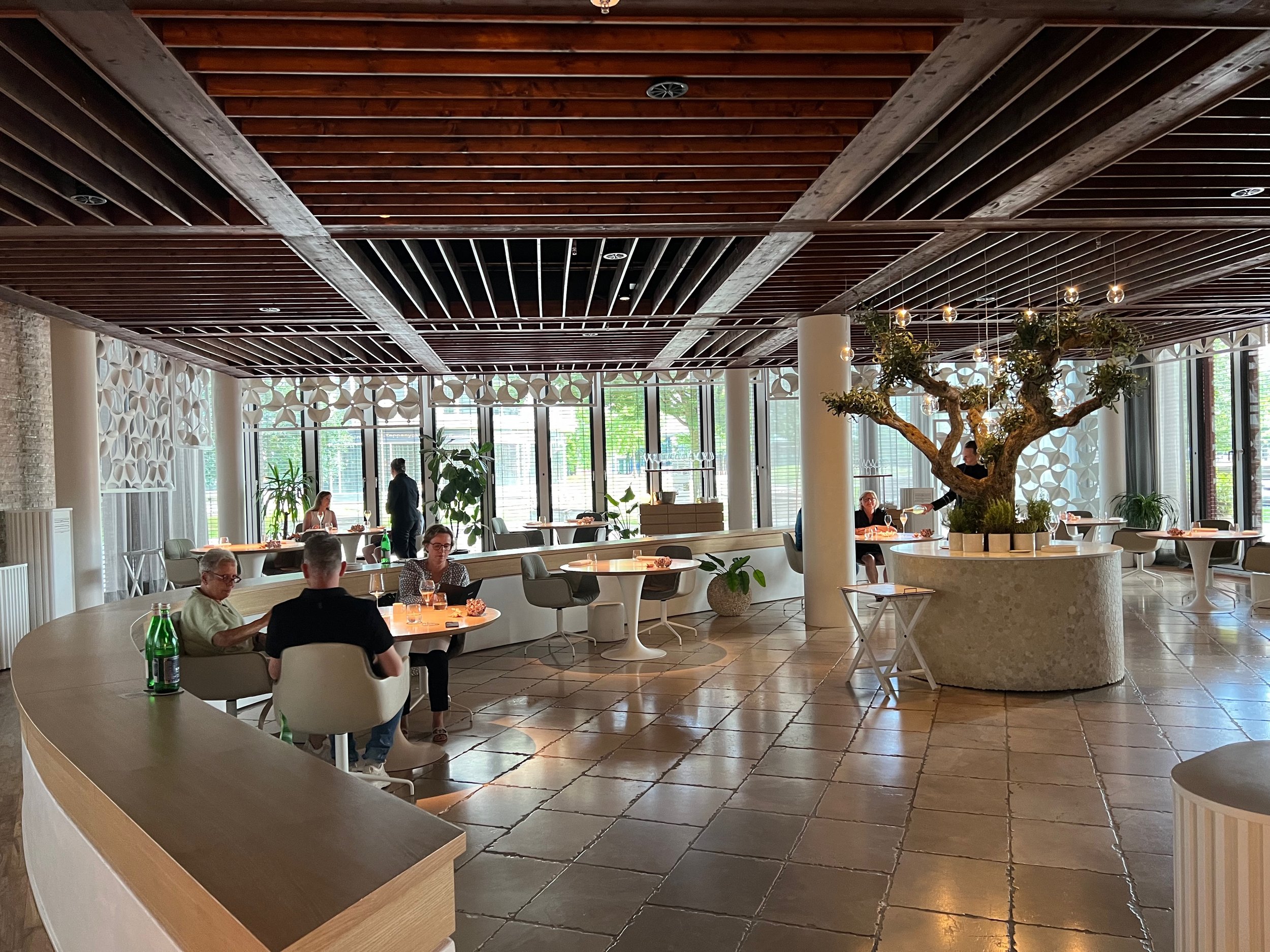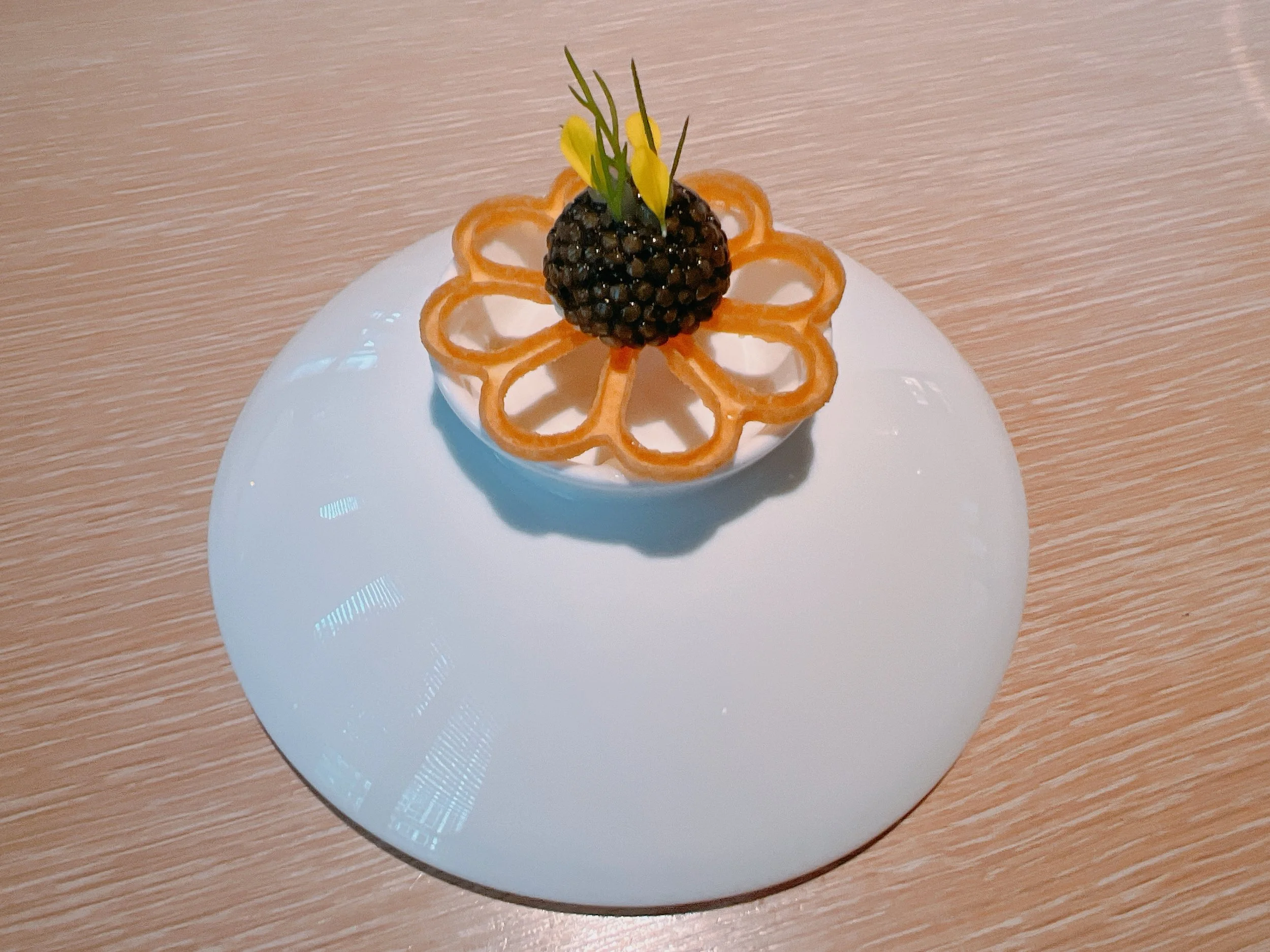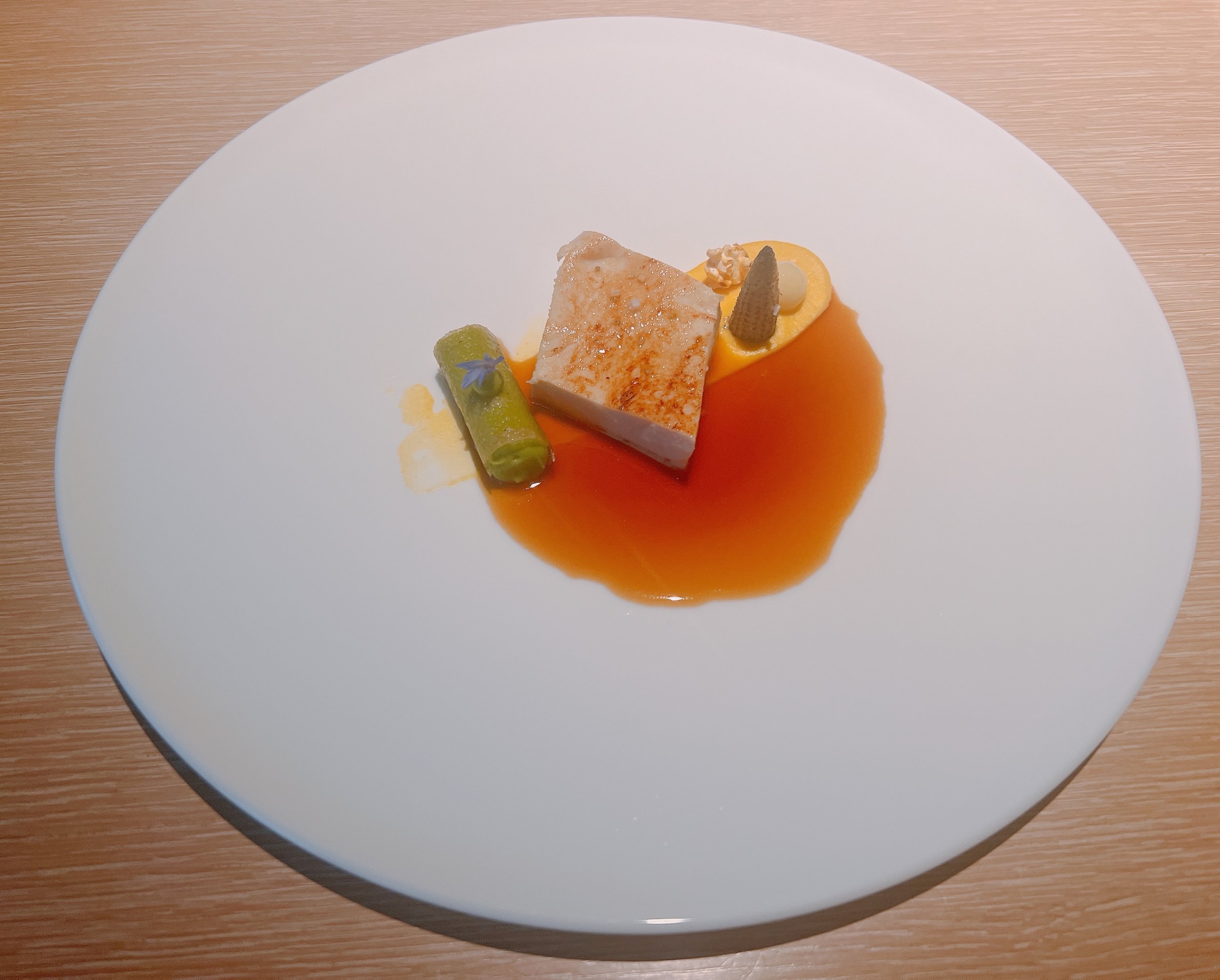Bianc - Hamburg
Rating: 15/20
Where: Hamburg, Germany
When: Dinner for 2 on 28 June 2024
Cost per Person: Tasting menu 250 Euro, Wine pairing 150 Euro
Accolades: 2 Michelin Stars
Why: Italian cuisine with some modern touches
“Bianc” is one of several Michelin-starred restaurants located in Hamburg's HafenCity, a part of the city that was historically used for the warehouses serving its port. In the recent past, the area has been redeveloped as a mixed-use zone full of apartments, office buildings, a dramatic symphony hall, and, yes, many restaurants. According to Bianc's chef-owner that's no coincidence, since the location is (a) close to downtown and (b) comes with few building-code restrictions, which makes it attractive for launching new restaurants.
For that reason, Bianc is on the ground floor of a new office building, and has an interior made to (loosely) resemble an Italian plaza, with an olive tree at the center and beige cobble-ish stones covering part of the floor. The open kitchen can be seen from most tables. The lack of table cloths kept the vibe semi-casual, but the service - while friendly - felt a bit too formal for the ambiance.
The wines in the wine pairing were unfortunately not too impressive, apart from an excellent dessert wine. They went decently with the food, though, so that should count for something. If I returned, I'd probably opt for some wines by the glass instead.
A one-sentence description of Bianc's culinary style might be “Italian with some modernist influences”. As if to illustrate this, our first two bites were an “olive” filled with (liquid) olive oil, and an “oyster” filled with a mousse derived from oysters. The surprise here was that the green olive-shaped object was the oyster-flavored one, and the one looking like an oyster pearl was the one that tasted of olives. We ate the olive-shaped, oyster-tasting bite first, and found it to be too fishy for comfort. But to be honest, I wonder how much of that reaction was due to the fact that we expected a totally different taste, namely of olives 14. The pearl-shaped, olive-tasting praline was much better, it burst with olive oil flavor, and was just a tad salty 17.
The following longish series of amuse bouches started with a trio. A macaroon made with cucumbers and bell peppers was a mix of textures and flavors. The cucumber was crunchy and had some acidity, while the macaroon melted in one's mouth and added some sweetness. While eating this bite, the perceived flavor interestingly varied quite a bit - very nice 16. A baby octopus sat on top of what looked like a bed of spaghetti. This “pasta” was actually deep-fried potatoes, whose taste reminded us of Pringles chips - not exactly what you'd expect from a two-Michelin-starred restaurant, but otherwise not bad 17. A little tartlet was filled with crab meat and topped with slivers of daikon. This was the weakest of the three bites. The first taste impression was of daikon, which then transitioned to crab. Pleasant, but not amazing 15.
Next, we were asked to come to the pass in the kitchen. Here, we were introduced to all the kitchen staff - a nice touch. Then we were served a small bite, a deep-fried bread ball filled with manchego cheese, chorizo and béchamel sauce, and topped with aioli and a small basil leaf. Oddly, this dish tasted just doughy and fatty, I couldn't make out either cheese or sausage flavors 12.
Back at the table, we received a little sandwich filled with beef tartare, and seasoned with dijon mustard, mayonnaise and oxalis. As beef tartare went, this was quite nice - the beef was of good quality. Unfortunately, the other flavors were pretty light, and the dish was a bit too salty 16. Next to this bite, possibly meant as a palate cleanser, was a cheese cracker made from 36-month-aged Parmigiano and a few drops of 25-year-aged Balsamico vinegar. As expected, this tasted strongly of cheese, but I couldn't detect the balsamic vinegar 16.
At this point, we had reached the main courses, which were each paired with individual glasses of wine - all the preceding appetizers had to make do with a single, shared glass. The first main course was blue fin tuna served with ginger and radishes. On the side was a little tartlet topped with creme fraiche and caviar. Starting with the tartlet: the caviar was decent, but the creme fraiche was hard to detect, and this bite was fairly salty overall 15. The tuna was of very good quality, the fish almost melted in one's mouth, and the ginger gave it an Asian touch. However, this dish was also very salty 17.
A French langoustine was served with a chili-papaya foam, bergamot and tomatoes. This dish ran the gamut of all different taste perceptions: the tomato was a bit acidic, the langoustine had some umami, there was some sweetness and (not a surprise at this point) a fair bit of saltiness 17.
Cod come prepared two ways. First, its neck was served as tempura. This was a disappointing bite - way too fatty and without much taste apart from the batter 12. Better, but also not great, was a cod filet served with a fig leaf and an Amalfi lemon sauce. The sauce was the best part here; and there were some crunchy beans hidden in it. The fish itself sadly didn't taste of much, though 14.
One of the restaurant's signature dishes was a tagliatelle carbonara, but it came with a twist: the pasta itself consisted of squid. It was with topped with a carbonara foam, squid ink, some guanciale and cheese. Unfortunately, (a) this dish had way too much foam, making it surprisingly heavy, (b) it apparently only had a single piece of guanciale - more would have been better -, and (c) the squid was way too chewy, making it a chore to eat. The idea behind this dish was good, but the execution was a bit lacking. It didn't help that we had had a far superior squid-as-pasta dish just a day prior 14.
The final savory course centered on a grilled chicken breast, served with chicken jus and a cannelloni filled with avocado. Also present were a corn cream and different “textures of corn”, such as a mini corn cob and a single popcorn kernel. A small focaccia bread rounded out the presentation. The focaccia was actually the weakest part of the dish, not as airy as focaccia usually is (maybe a 13 by itself). The chicken was juicy and some salt on top brought out its flavor. The corn cream was even better, tasting of corn without being too sweet 16.
The sweeter part of the menu began with a small bite: a choux pastry made with flavors of banana, licorice and chocolate. Interestingly, the dish seemed to contain ice cream, so ended up being somewhat cold. Amazingly, the flavors went very well together, making this a really nice banana dessert, with the banana flavor present but not overwhelming - a hard balance to get right 17.
The main dessert was made with vanilla ice cream, chocolate cream, a little sphere filled with a coffee mousse, tangerines and gooseberries. The chocolate cream was somewhat overwhelming, the dish might have been better without it. The rest was pretty good though, with the ice cream being especially lovely 15.
Three petit fours ended our dinner. A sandwich was filled with crema catalana (a Spanish crème brûlée), mango and orange. It was very crunchy and had only a light fruit flavor 14. An apricot praline tasted mostly of sulfured dried apricots - fresh apricots might have been better 14. Finally, a dish called “textures of nuts” had indeed different textures - sticky and creamy -, but oddly (given that it was based on nuts) not much crunch 14.
Overall: A modern Italian dinner with some good dishes, but also some less successful ones. Given that all courses sounded good on paper, this was mostly an execution issue, as was the occasional overuse of salt. In all, this was not a bad meal, and we appreciated the good - although a bit too formal - service and several interactions with the enthusiastic chef. However, the food didn't quite meet the expectations raised by the two stars with the corresponding price tag 15.



















